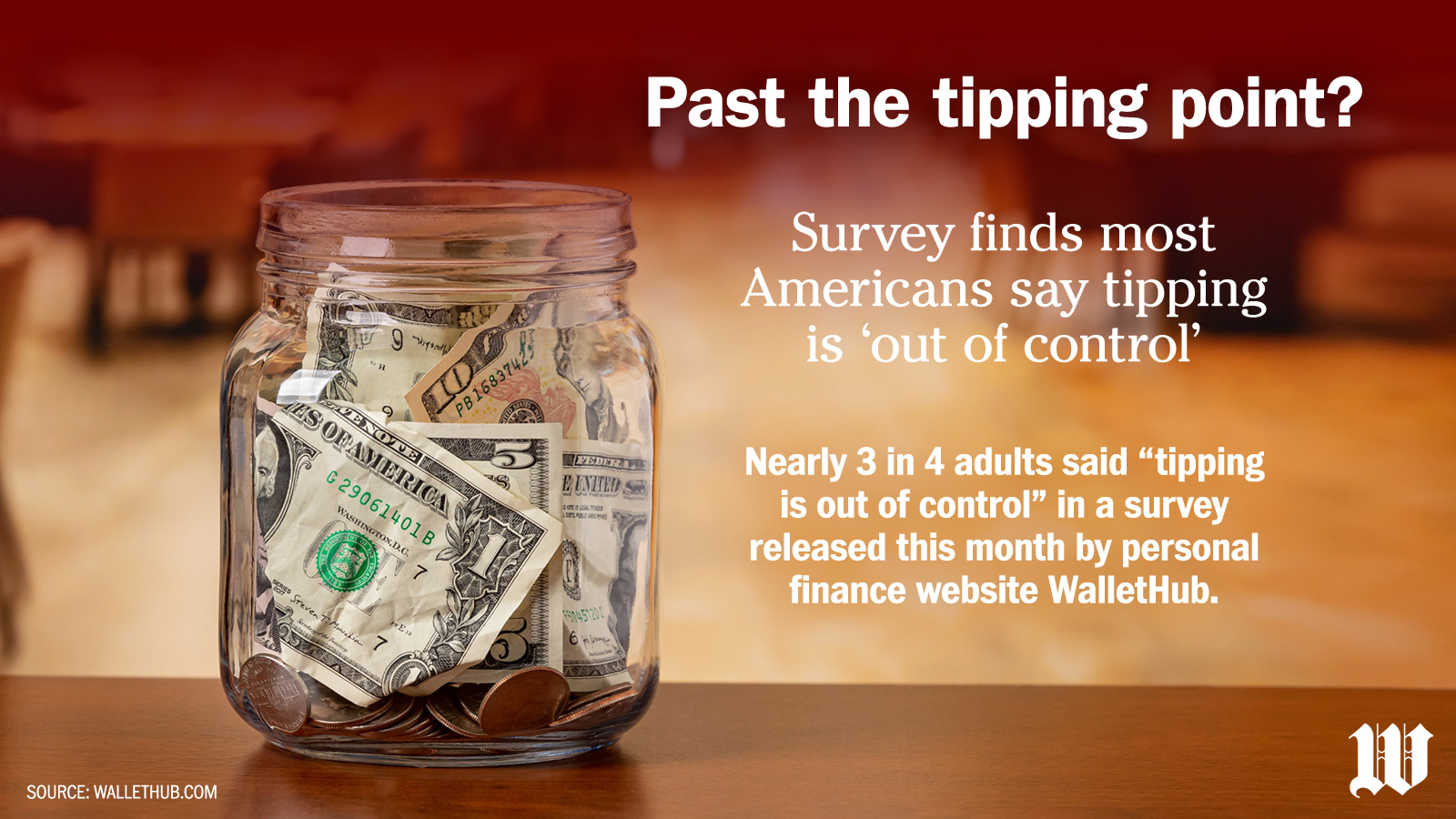Automatic tip prompts of up to 25% for Chinese takeout. Self-swipe card readers adding an 18% gratuity to a Steak ’n Shake bill. A 15% tip for a $2.73 cruller at Dunkin’.
Tipping expectations for casual restaurants, meal delivery apps and grab-and-go food after the COVID-19 pandemic emergency have irked Americans who no longer feel able to be generous amid high inflation.
Nearly 3 in 4 adults said “tipping is out of control” in a survey released in March by personal finance website WalletHub.
A reported 64% agreed that “a tip is something you should give when you feel like it instead of something you always have to give,” and 78% favored banning automatic service charges for large orders. Nearly 3 in 5 said that “businesses are replacing employee salaries with customer tips.”
“The culture of tipping in the fast-food industry has undergone a significant change in recent years,” WalletHub analyst Cassandra Happe said. “Many people today believe that tipping practices have become excessive and unfair.”

Ms. Happe urged businesses to review their tipping policies, boost wages and “reduce the pressure on customers to tip.”
Casual restaurants and food vendors that struggled under pandemic restrictions have sought new ways to cover rising operating and labor costs.
Last month, Wendy’s CEO Kirk Tanner said the burger chain would begin testing digital menus that employ surge pricing, allowing owners to change prices throughout the day based on demand. For example, prices could rise during the lunch rush and fall at 11 p.m.
The news stirred intense opposition among customers on social media. Some said they would dine elsewhere to avoid price increases.
Wendy’s made an abrupt U-turn and announced a day later that it would not be “raising prices when demand is highest.”
To tip or not to tip
Americans traditionally offered tips only as a reward for sit-down service, but many started leaving tips for salads, sandwiches and coffee during the pandemic emergency.
Industry insiders interviewed by The Washington Times credited the popularity of delivery apps such as Uber Eats, Grubhub and Door Dash during stay-at-home orders for pushing tipping into “fast-casual” settings.
They said the practice outlasted pandemic restrictions as more fast-food restaurants, bakeries and coffee shops replaced tip jars with digital prompts to tip 18%, 20% or 25% of each bill after tax.
“The desire to ‘tip everywhere’ definitely saw a dramatic increase during the COVID years,” said Anthony Gill, a University of Washington political scientist who studies tipping. “I think a lot of folks felt bad for service workers who were laid off or working shorter hours, so tipping really took hold for picking up food.”
Mr. Gill said he bases his tips on the pre-tax amount of his restaurant bills, avoids tipping for pickup orders and does not add a gratuity if a bill includes an automatic service fee.
Will Hild, executive director of the right-leaning advocacy group Consumers’ Research, said payment apps such as Square have made it easier for food trucks to process tips on smartphones.
“So customers are now routinely being asked to tip in transactions where, until very recently, tips were generally not expected,” Mr. Hild said.
As more Americans feel pressured to keep up with early-pandemic tipping practices, fast-food prices have outpaced wage growth.
According to the Bureau of Labor Statistics, compensation broadly rose by 13.8% from December 2020 to December 2023. By comparison, First Data Merchant Services Corp. reported that the average “ticket growth” among all fast-food restaurants rose by 19.5% over the same period.
Paul DeCamp, an administrator of the Department of Labor’s wage and hour division in the George W. Bush administration, emphasized that customers “remain free not to tip if they choose not to.”
“I wouldn’t necessarily describe tipping as out of control,” said Mr. DeCamp, a lawyer who helps employers comply with federal wage laws. “But I think there is more of a willingness these days for businesses and workers to consider pushing the envelope to see whether customers will tip in new settings or in contexts where tipping was not historically the norm.”
The U.S. norm of tipping 20% is a social outlier internationally, said Karene A. Putney, a business consultant at Maryland-based Etiquette Etiquette and a 2019 graduate of the Protocol School in the District of Columbia.
She noted that a customary tip in Europe, the Middle East and Latin America is 10% to 15%, a gratuity in Australia or New Zealand averages 10% and restaurants in Asian countries prefer “a polite thank-you.”
“Overall, tipping is a personal choice, and it’s important to think about what feels right for you and the situation,” Ms. Putney said.
Fast food was once cheap fare for poor Americans but has become a luxury for that demographic as pressure mounts on small businesses to raise prices.
A recent survey from PublicSquare and Idaho-based jobs board RedBalloon found that 75% of small-business owners reported their supplier prices had increased over the previous 30 days.
“In this environment, small businesses can’t afford wage increases, which makes it extremely difficult to find and retain new talent,” RedBalloon CEO Andrew Crapuchettes said. “For many, tips are an essential strategy to help relieve that pressure.”
Inflation has left restaurant owners with no good alternatives, said Lee Schalk, vice president for policy at the American Legislative Exchange Council, a network of conservative private investors and state legislators.
“They can raise menu prices, slash payroll or close their doors,” Mr. Schalk said.
Federal law requires restaurant workers to earn at least minimum wage but allows restaurants to satisfy part of that obligation through tips.
According to the National Restaurant Association, tipped restaurant workers earned $19 to $25 an hour on average when President Biden took office in January 2021.
John R. Hendrickson, policy director at the Tax Education Foundation of Iowa, said the problem is that the quality of service in fast-casual restaurants has not necessarily increased alongside tipping expectations.
“Tipping is fine if the service is good, but people should not be expected to tip for no service at all or even poor service,” Mr. Hendrickson said. “I do think that tipping is getting out of hand … and the built-in charges mask the larger problem of low wages in the service sector.”
Economists trace the practice of tipping at restaurants and hotels to the upper class of 16th-century England, which created it as a status symbol. It spread through Europe and was common in the United States by the Colonial period when Benjamin Franklin mentioned it in his journals.
Tipping grew more widespread during periods of prosperity in the late 19th century, the 1920s and the decades after World War II.
No complaints?
The customary U.S. tip grew from 10% in the 1960s and 1970s to 15% or more in the late 1980s before jumping to 20% in the 21st century.
Sean Higgins, an analyst at the libertarian Competitive Enterprise Institute, said the switch to digital screens with pre-loaded 18%, 20% and 25% gratuities has pressured diners to pay even more in recent years.
“It could be a psychological thing to make you give 18% instead of nothing,” Mr. Higgins said. “That’s an old marketing trick, to have more expensive options that make another look cheaper and more reasonable.”
Federal statistics show the core Consumer Price Index for all goods except food and energy has risen 16.7% since January 2021, but prices for food away from home have soared by 21%.
Some experts predicted that negative feedback on fast-casual tipping would pressure some food vendors to give it up in the next few years.
“It’s likely that as time goes on, seeing service fees on checks will lead some restaurant patrons to either leave smaller tips or not tip at all, considering the overall increase in prices in the past few years,” said Peter C. Earle, an economist at the free market American Institute for Economic Research.
Many casual restaurants do not officially condone tipping, but some managers informally tell employees to keep what they get.
Reached for comment, some fast-food chains said they had not received complaints about stores that unofficially allow tipping.
“Our stores are independently owned and operated,” said a Dunkin’ customer service representative. “We have not had any complaints.”
“We have many different stores with different policies modified to suit their purposes,” said a customer service representative for Wendy’s. “I’m not aware of any complaints.”
Starbucks said customers may leave tips by cash, digital app tip or credit card transactions at the register.
“Tipping is optional, and customers have multiple options to show their appreciation for baristas,” a Starbucks spokesperson said.
John Schall, owner of eight fast-casual El Jefe’s Taqueria restaurants in Pennsylvania, New Jersey and Massachusetts, pays his employees an hourly wage of $17 and allows customers to tip when they check out.
“Tipping is not out of control,” Mr. Schall said. “Nobody has complained that we offer the option, and 60% to 70% of my customers don’t tip. Nobody is holding a gun to their heads.”
A restaurant chain owner in the Washington area who asked to remain anonymous said two of his restaurants recently closed.
“As an industry and culture, we’re currently in a transition period, and there is likely to be some bumps along the way as we all figure this out together,” he said. “In regards to inflation, costs will always get passed on to consumers.”
• Sean Salai can be reached at ssalai@washingtontimes.com.



Please read our comment policy before commenting.